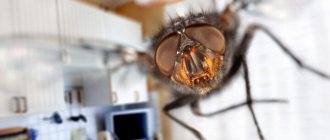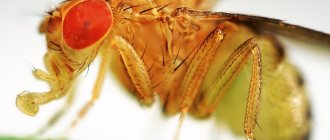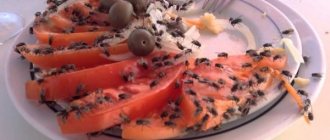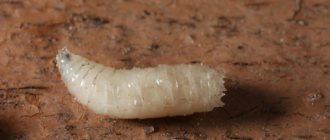Body parts and integument
Insects are distinguished by an enviable species diversity: approximately 1.5 million. Moreover, this figure is minimal. Despite this, they all have a common structure plan. The body of insects is clearly divided into three sections. These are the head, chest and abdomen. The middle section bears three pairs of limbs and wings.
The internal organs of insects are reliably protected by the external skeleton - the cuticle. Its outer layer is formed by fatty substances that prevent excessive moisture loss. Odorous or poisonous glands are also located here. The color of the insect depends on the type of pigments found in the middle layer of the cuticle.
Musculature
Insect muscles are unique. They have extreme contraction power. Thanks to this, some insects can lift a load tens of times greater than their own. Another feature is the frequency of contractions. This causes various forms of flight: active, forward, passive, hovering. Skeletal muscles contract the limbs and move the wings. It is formed by striated tissue. The heart of insects consists of muscle fibers covered with a layer of epithelium.
Nervous system and sensory organs
These representatives of the phylum Arthropods are characterized by complex behavior. There are many examples of insects that are social: bees, bumblebees, termites, ants. They live in entire groups, in which each member has his own “responsibilities.” All this is possible thanks to the development of the nervous system of insects. It is represented by the abdominal chain, which distinguishes the brain, segmental and subpharyngeal nodes - ganglia.
The organs of vision are located on the head. These are simple and compound eyes. The latter form mosaic vision. Each small eye perceives only part of the image, but together a real holistic picture is formed.
The head also contains antennae, which are organs of touch. Similar structures are evenly distributed over the entire surface of the body of insects. They are connected to nerve endings called receptors. They perceive various types of irritations: chemical, mechanical, temperature.
Structure of flies
The structure of the fly, despite the small size of this insect, is complex. A fly under a microscope looks quite interesting; the image differs significantly from a “living” individual.
Body Features
It is quite massive, covered with hairs and divided into three main sections - abdomen, head and chest. The smallest representatives of this kingdom have a body length of only 0.17 mm. Representatives of the largest flies reach a length of up to 12 cm. The speed of the fly is amazing: adult flies can fly at a speed of more than 20 km/h. This flight speed is quite impressive.
insect eyes
The fly's vision is quite well developed; on the sides of the head there are two large eyes, formed through complex structural elements. The lens of each eye is equipped with an interesting hexagon shape. The number of facets can be about 4,000 pieces in each eye. They all come together, during which the brain can form an overall picture. The all-round field of vision provides this insect with special insight. It takes a fly several times less time to identify objects than a human. The structural features are evidenced by the eyes of the fly, which can be seen under a microscope.
Fly antennae and structural features
There are small antennas on the insect's head; these are the antennae, consisting of three segments. These organs provide an improved sense of smell and are not used as organs of touch. The ability to detect food by smell allows flies to quickly fly to the place where it accumulates. This explains why flies are so fast.
Fly legs and their features
The legs of insects have their own joints. How many legs does a fly have - 6 legs, consisting of 5 joints. On the paws there are other organs - two claws, as well as thin hairs and glands that can secrete a highly sticky substance consisting of fats and carbohydrates. This feature explains why the fly does not fall from the ceiling. It is believed that the insect seems to “glue” to the surface, landing on the ceiling or walls. A decisive role here is also played by hairs that can “cling” to uneven surfaces.
Foot friction
We have looked at how many legs a fly has; it remains to answer the question of why flies rub their legs. While crawling on various types of surfaces, sticky pads located on the paws collect dirt when the insect lands on the ceiling, on food and other places, or when flies land on a person. Because of this, the ability of small legs to adhere to the surface is impaired, so you have to constantly clean the wool from particles of debris and dirt. Now it’s clear why houseflies rub their legs, and they can rub them for a long time.
At the tips of the legs of each insect there are special bristles that act as organs of taste and touch. That is, these representatives of insects first sense tastes with the help of their legs, and then the proboscis and sucking blades begin to work. At the same time, the analysis of how useful certain findings are for a fly is 100 times better than for a person using the tongue.
Digestion and excretion
The digestive tract of insects is of a through type. A characteristic feature of insects is the presence of salivary glands and the absence of a liver. Some representatives have specialized glandular cells that also secrete enzymes.
Among insects, extraintestinal digestion is also found. For example, ladybird larvae inject enzymes into the body of the victim. This is how their contents are digested.
The excretory organs of insects are the Malpighian vessels. These are tubes with the blind end facing the body cavity and the other end facing the intestines. They receive hemolymph. From this fluid, metanephridia releases end products of metabolism, which are excreted through the intestines.
Circulatory and respiratory system
These systems are functionally interconnected. The main circulatory organ of insects is a single dorsal vessel. This is a hollow muscular tube. Its posterior section is the heart of insects, and the anterior section is the aorta.
Free-living species breathe using tracheas. They open outwards with special openings called spiracles. Through them, oxygen from the atmosphere penetrates into the tracheae, then into their branches - tracheoles, and as a result ends up inside the cells. Here the oxidation of organic substances occurs.
Removal of carbon dioxide can occur in the opposite direction through spiracles,
Reproduction and development
All insects are dioecious. In some species, sexual dimorphism is clearly manifested - differences in the morphological characteristics of individuals of different sexes. Examples of insects that exhibit dimorphism are beetles—deerflies, dragonflies, and butterflies.
Another characteristic feature is internal fertilization. This means that the fusion of gametes in insects occurs inside the female body. But further development can occur in different ways. In some species, eggs hatch into individuals that do not differ in appearance from adults. These are insects with incomplete metamorphosis.
Brain structure
When thinking about the brain, many people see a picture of a round substance with convolutions pop up before their eyes. With a fly things are different. The Diptera brain consists of 3 sections, namely:
- tritocerebrum;
- protocerebrum;
- deutocerebrum.
Despite its fairly simple structure, the brain is responsible for the functioning of the entire body. At the same time, the fly is not able to think. She acts instinctively.
Due to the arrangement of cells in the outer layer and the fibers leading to them, the fly’s brain can be compared to the control organ of a human or animal.
Inside the protocerebrum there are additional sections. Which are divided into:
- central body;
- intercerebral part;
- protocerebral lobes;
- protocerebral pons;
- ventral bodies;
- optic lobes;
- stalked bodies.
Important: bees and ants have similar additional sections.
In some species of flies these roots are not observed.
Deutocerebrum differs from protocerebrum in its simplicity. The structure diagram corresponds to a normal ganglion. This can only be explained by the fact that this section is the nerve center of only one segment - the mustache.
The department is usually called the tertiary brain. His position is clear. The tritocerebrum is located between the other sections. However, the brain does not have a specific shape. The only thing we can say with certainty is that it is divided into;
There is a small jumper between the two halves. It passes under the intestines.
The main function of the tritocerebrum is to control the mouth and upper lip. The second may be absent in some types of flies.
Important: Tritocerebrum is associated with the sympathetic nervous system.
Important: before taking off, the fly places its legs in such a way as to push off in the direction opposite to the approaching object.
The brain has time to assess the situation and make a decision, even if the insect:
- cleans the wings;
- eats;
- moves in space or along the surface of a wall.
Flies, like most insects, are capable of learning. It all depends on the situation the pest finds itself in. Of course, this is not the same as what happens to a person. The insect remembers everything at the genetic level.
The brain function of insects, including flies, is being studied in many universities. Experiments allow us to understand how pests survived in the past and how much they have changed.
Do insects have a brain and how does it work?
Despite the fact that insects seem to be rather primitive creatures, curious researchers often have questions.
How does their nervous system work? How do individual species organize hierarchy? If they are so organized, does that mean they have a brain? And if there is a brain, is it different in different types of insects? In this article we will try to answer these questions.
Insect intelligence research
Insects are a huge class of invertebrate arthropods. Their habitat is almost limitless. They are found in any climate and at almost any latitude.
Each species has its own distinctive behavior and lifestyle. For many centuries, scientists have tried to figure out how the behavior and lifestyle of individuals is connected to their brain.
Moreover, the attitude towards the intelligence of this class has changed greatly over time.
In ancient times, people idolized insects, considering them the smartest creatures on the planet. Thus, the ancient Egyptians believed that a beehive represented a small state with a bee pharaoh. And some ancient philosophers and scientists seriously thought that bees could have a slave system.
Depiction of bees on an ancient Egyptian fresco
In the Middle Ages, the point of view on the intelligence of insects changed. Now, some natural scientists considered beetles to be peculiar mechanisms, incapable of thinking and analysis and relying only on reflexes.
In the 19th century, scientists returned to discuss the question of the presence of intelligence in this class. Now the great minds of that time were divided into two camps.
Some believed that social insects are capable of thinking, others tried to prove that behavior and lifestyle are just a set of reflexes.
Few scientists attributed bees' behavior to their ability to learn; most believed it was instinct. This judgment was associated with small brain size.
The brain of insects is indeed significantly different from the human one, the number of neurons in it is about 1 million, while the human brain consists of 86 billion neurons.
For this reason, scientists have not studied the insect brain in detail for a long time, considering it primitive.
However, several studies have shown that the cognitive abilities of insects are comparable to those of many vertebrates! This discovery has again sparked interest from the scientific community in studying the nervous system of bugs.
At the end of the 20th century, thanks to advances in genetics, it was proven that insects have neither exclusively innate nor exclusively acquired skills. And although their behavior is innate, it is influenced by acquired experience, which allows them to adapt to a certain type of food or to a certain area.
Protocerebrum
The primary brain or protocerebrum is the largest section. It is responsible for all processes occurring in the body. This part is divided into several zones that have different structures and are responsible for different functions.
The protocerebrum consists of neurons responsible for processing and analyzing information. Externally, the protocerebrum resembles the large brain of mammals. Inside the primary section are fibrous masses called neuropilar masses, formed from the processes of nerve cells.
With the help of neuropils, the brain is divided into several separate parts.
This department, in addition to coordinating the work of the body, is responsible for vision, as well as for the interaction between individual individuals. Thanks to the protocerebrum, some species are capable of organization.
Scientists have noticed that in insects with a more complex organization, the protocerebrum is more developed. With the help of stalked bodies, associations are formed and more detailed processing of information occurs, helping to form connections between individuals. In collective insects the number of stalked bodies is much greater. For example, in bees these bodies occupy up to 20% of the brain, and in flies or cockroaches less than 2%.
Features of the insect brain
So, we found out that insects have a brain, and besides, it is not the simplest in structure.
It is because of this complex structure that individual species, such as bees or ants, are capable of forming hierarchy and structure.
This is what helps ants pass on experience to younger generations, showing them the way to get food, or grow aphids in certain places, and bees remember inflorescences where nectar can be found.
Ants
This helps to find the way to the flower, where she collected a large amount of nectar the day before. In addition, recent research has shown that insects can be trained in a targeted manner.
So, scientists trained a bumblebee to move a ball to a certain place, after which the bumblebee received a sweet syrup. Several individuals easily remembered the procedure and repeated it.
Insects also have excellent spatial orientation. Bees or bumblebees remember surrounding objects, ants make paths to food, and dung beetles can navigate the starry sky even at night.
Insects are not the most primitive creatures, as many of us are accustomed to think. Their brains are both simple and complex. For many species, this structure of the nervous system helps them avoid danger, find food, and even organize a hierarchy in the nest.
Source: https://bezbukashek.ru/%D0%B1%D0%B5%D0%B7-%D1%80%D1%83%D0%B1%D1%80%D0%B8%D0%BA%D0% B8/nervnaja-sistema-nasekomyh-est-li-u-nih-mozg
general information
Let's start the story with the question posed in the title, let's find out how long the common fly lives.
In fact, flies do not live very long; their average lifespan is between one and four weeks. If the temperature is kept at 20-25 degrees and there is enough food, then individual individuals are able to not die for two months.
On a note! We are talking, of course, about the imago - an adult insect!
Many people are concerned about the body weight of this insect, so the second question to which we will answer: how much does a fly weigh.
Importance of flies in nature
Considering the question of what flies are needed for, it can be noted that they have a special place in the natural food chain. They eat all sorts of things - mainly carrion and waste, thereby cleansing the environment to some extent. Flies that sleep at night can serve as food for birds and animals of prey, as well as other insects. But as for home conditions, a fly is an insect that, as we have already noted, brings enormous harm to humans. Food consumed by humans can become a site for egg laying, and such food eaten can lead to serious consequences in the form of diseases of the intestines and other organs.
Generation or life cycle
Now let's talk about the development of the fly from a scientific point of view. The life cycle of a fly follows the path of complete transformation of insects.
Attention! The complete development cycle of insects includes four stages: egg, larva, pupa and adult!
Flies are capable of laying up to one hundred and fifty eggs at a time. During her short life, the female is capable of laying more than six eggs. It is also interesting how flies lay eggs. They are able to place them in any food that has begun to spoil, which is why it is so important to monitor the accumulation of garbage and remove it from the apartment in a timely manner.
Fly eggs are very difficult to see, as they are less than one millimeter in size.
The eggs are incubated very quickly, and literally the next day small larvae - maggots - appear. They emerge from the egg very tiny, but during development they are capable of growing more than eight hundred times.
The entire development process of maggots lasts a little more than a week under favorable conditions: an optimal temperature of 20-25 degrees Celsius and high humidity of the air and substrate in which they develop.
Maggots are in great demand among fishing enthusiasts, but for a housefly they are small and are not suitable for baiting a hook. Usually the bait is supplied by other types of flies, the so-called meat flies.
The next stage of fly development is the pupa. The larva stops feeding and increasing body weight and size and gradually pupates. Anglers call pupating maggots caster and are also used for bait.
The caster is similar to the larva, only it has a harder shell and a brownish body color. The fly also spends about one week in this stage of development.
Our help! At low temperatures, the fly larva is not able to pupate. Therefore, fishing maggots can be stored in the refrigerator for six months or more.
A week after pupation, the last stage of flies appears. As stated earlier, adult individuals live on average for about twenty-four days, and they are able to lay eggs almost every two or three days. So these same 75 tons per year come out!
Anatomy of a fly - external structure
The general plan of the structure of dipterans, the skeleton of a fly is the same as that of other insects - head, chest, abdomen. The head contains the mouthparts, antennae, and eyes. The chest consists of three segments, with a pair of transparent wings, and three pairs of legs. The space in the chest is filled with powerful muscles. The abdomen includes most of the digestive organs and the reproductive system.
Flies have pronounced sexual dimorphism, when the appearance and structure of the female differs from the male.
Fly head
Includes the organs of vision, nutrition, and hearing.
- Oral apparatus. Regardless of the differences in nutrition of many species of flies, their oral apparatus is represented by a proboscis of a sucking, licking type. A pair of extended blades of the upper and lower lips come into contact with food. The fly's jaws are powerful. Numerous tubules converge in the fly's proboscis, at its central point. The mouthparts of a fly that feeds on blood are additionally equipped with hard, sharp scales that serve as teeth and help pierce the skin of animals and humans. The liquid is drawn into the head using a pharyngeal pump.
- The eyes occupy most of the head. They form a complex system, which was taken as the basis for the development of a modern photo camera. They consist of many simple eyes that look like a faceted mesh from the outside. The insect receives a comprehensive but mosaic image of objects. Each eye includes several hundred or thousands of facets. The housefly has about 4 thousand of them. Many species have 3 simple eyes located on the crown of the head. This structure allows you to instantly capture movement, but does not provide a complete picture of the image.
- Mustache. A kind of antenna serves as a landmark. They help to catch odors and determine the direction of movement. In the process of evolution they changed, there are differences in males and females.
Males always have larger eyes than females. This allows them to react faster to movement and better assess their surroundings. Females have a more developed olfactory system, with the help of which they find a favorable environment for laying eggs.
The structure of a fly's head
Breast
Consists of three segments - prothorax, midthorax, metathorax. The bones of the fly and the main part of the muscles provide flight, so the middle part is the most developed. How many legs does a fly have? 3 pairs. Each consists of 5 parts and has its own powerful muscles. The structure of the fly's paws ends with claws and suction cups, which allow the insect to stay on a vertical, horizontal surface and even upside down. When walking, the soft pads compress and secrete a sticky secretion. This feature helps flies to hang on and move freely on window glass and smooth surfaces.
The paws are one of the main sense organs - smell. Using its legs, the insect determines the taste of food and analyzes the quality. After a few seconds of analysis, it begins to feed or flies away.
Wings of a fly
The upper ones are well developed, transparent, membranous. The posterior pair is deformed into appendages - halteres. They maintain balance in flight, allow them to hover in the air, and also make a buzzing sound. Thin wings are reinforced with cylindrical veins.
During the flight, an insect can turn off one or the other wing, abruptly change its trajectory, perform complex maneuvers, and take off without preliminary acceleration. The structure and abilities of the insect were taken as the basis for many flying structures in airplanes and helicopters.
Abdomen
It has a cylindrical shape, elongated, consists of 10 segments, includes the organs of the fly responsible for reproduction, respiration, nutrition and other important functions. The elastic chitinous cover expands as food arrives during pregnancy. Therefore, the weight of the fly varies depending on these conditions.
An ordinary housefly or housefly weighs 12 mg; during pregnancy, the weight increases to 15 mg. Your weight can increase to the same level after a meal. The male is smaller, weighing about 12 mg. One gram contains about 80 of these insects.
The face of a fly can be easily seen under a microscope, but even when carefully examined with the naked eye, one can see an elongated mouthparts and large eyes of green, red, yellow, brown, and blue. The ears of a fly are located on different parts of the body and help to detect air vibrations and ultrasound.
Do flies bite?
People often say that with the onset of autumn cold weather, usually peaceful house flies become extremely biting and cause a lot of trouble. It turns out that a completely different species of these insects flies into our homes - the autumn fly. In summer, this creature lives in fields and meadows, feeding on the blood of domestic and wild animals, and cold weather drives it to our warm homes.
So don’t blame the housefly, the bites are caused by a biting burner that looks like it.
This is our familiar and interesting housefly. And to consolidate the material, watch a video report about how a fly is born. Interesting video footage shows the process of transformation of an insect from a pupa into an adult.
The fly has a unique brain
Flies were found to process 100 frames per second.
And this allows them to detect an obstacle during flight within a few milliseconds (a millisecond is one thousandth of a second). In particular, the researchers focused their attention on optical flows, which they called "optical field flows." It appears that this optical field is processed only by the first layer of neurons. They process the “rough” source signal from each fly “pixel”. And they forward the processed information to the next layer of neurons. And, according to the researchers, there are only 60 of these secondary neurons in each hemisphere of the fly brain. However, the fly brain manages to reduce or fragment the field of view into many sequential “motion vectors” that give the fly a vector of direction of movement and “instantaneous” speed. And what’s interesting is that the fly sees it all! We, people (and not everyone), know what a vector and instantaneous speed are. And the fly, naturally, has no idea about these things. And such abilities of the fly’s brain to process a huge amount of information can only be envied. Why do we see only about 50 frames per second, and the fly 100? It's hard to say, but there are reasonable guesses on this matter. How does a fly fly? Almost “instantly”, with enormous acceleration. We could hardly withstand such an overload. But it is possible to create a robotic brain that is as fast as the brain of a fly in processing information flows.
To try to understand how a tiny fly brain can process such a huge amount of information, researchers in Munich have created a “flight simulator” for a fly. The fly could fly, but was kept on a leash. Electrodes recorded the response of the fly's brain cells. And researchers tried to understand what happens in the fly’s brain during flight.
The first results are obvious. Flies process images from their fixed eyes very differently than humans do. When a fly moves in space, “optical flux fields” are formed in its brain, which give the fly the direction of movement.
How would a person see it? For example, when moving forward, surrounding objects would instantly scatter to the sides. And objects in the field of view would appear larger than they actually are. And it would seem that nearby and distant objects move differently.
The speed and direction with which objects flash before the eyes of a fly generate typical patterns of motion vectors - field flows. Which, at the second stage of image processing, reach the so-called “lobula plate” - the center of vision of a higher level. In each hemisphere of the fly's brain there are only 60 nerve cells responsible for vision. Each of these nerve cells responds only to a signal with a certain intensity.
But for the analysis of optical flows, information coming from both eyes simultaneously is important. This connection is provided by special neurons called “VS cells”. They allow the fly to accurately assess its location in space and flight speed. It appears that the “VS cells” are responsible for sensing and responding to the torque applied to the fly during its flight maneuvers.











